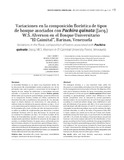Mostrar el registro sencillo del ítem
Variaciones en la composición florística de tipos de bosque asociados con Pachira quinata (Jacq.) W.S. Alverson en el Bosque Universitario “El Caimital”, Barinas, Venezuela
| dc.rights.license | http://creativecommons.org/licenses/by-nc-sa/3.0/ve/ | |
| dc.contributor.author | Moret, Ana Yajaira | |
| dc.contributor.author | Plonczak Ratschiller, Miguel Andrés | |
| dc.contributor.author | Jeréz R., Mauricio | |
| dc.contributor.author | Garay, Vicente | |
| dc.contributor.author | Valera, Lino | |
| dc.contributor.author | Ramírez, Nelson | |
| dc.contributor.author | Hernández, Dimas | |
| dc.contributor.author | Mora, Argenis | |
| dc.date.accessioned | 2010-10-21T22:05:32Z | |
| dc.date.available | 2010-10-21T22:05:32Z | |
| dc.date.issued | 2010-06-30 | |
| dc.identifier.issn | 0556-6606 | |
| dc.identifier.uri | http://www.saber.ula.ve/handle/123456789/31645 | |
| dc.description.abstract | La diversidad biológica es un tópico muy importante dentro de las discusiones de sustentabilidad, siendo actualmente uno de los principales retos para la gestión y conservación de los bosques. El objetivo de este trabajo fue determinar si comunidades boscosas asociadas a la presencia de la especie arbórea Pachira quinata, diferenciadas por la posición geomorfológica, presentan diferencias en su composición florística, medida con índices cuantitativos de diversidad. Para ello, se establecieron seis parcelas de 1 ha, ubicadas según un diseño aleatorio con restricciones. En cada parcela, se midieron todos los individuos de especies arbóreas con dap = 10 cm y una submuestra para los individuos entre 2,5 y 10 cm. Se estimaron las diversidades alfa y beta, el Índice de Valor de Importancia (IVI) y se realizó un análisis de conglomerados para determinar si existían similitudes florísticas entre los tipos de bosque. Se encontró que al considerar los individuos con dap = 10 cm tanto el análisis de los Índices de Diversidad Beta (Jaccard y Sorensen), como el análisis de conglomerados permitieron identificar la existencia de dos grupos de acuerdo a su similitud florística. Un grupo estuvo conformado por los tipos de bosque ubicados en las posiciones geomorfológicas banco + subbanco y un segundo grupo ubicado en la posición de bajío, donde los suelos tienen limitaciones de drenaje que solo pueden ser toleradas por ciertas especies, por lo que su diversidad fue menor y su composición florística diferente de los otros tipos de bosque. | es_VE |
| dc.language.iso | es | es_VE |
| dc.publisher | SABER ULA | es_VE |
| dc.rights | info:eu-repo/semantics/openAccess | |
| dc.subject | Diversidad alfa y beta | es_VE |
| dc.subject | Saqui-saqui | es_VE |
| dc.subject | Sostenibilidad ecológica | es_VE |
| dc.subject | Clasificación de tipos de bosque | es_VE |
| dc.title | Variaciones en la composición florística de tipos de bosque asociados con Pachira quinata (Jacq.) W.S. Alverson en el Bosque Universitario “El Caimital”, Barinas, Venezuela | es_VE |
| dc.title.alternative | Variations in the florac composition of forests associated with Pachira quinata (Jacq.) W.S. Alverson in El Caimital University Forest, Venezuela | es_VE |
| dc.type | info:eu-repo/semantics/article | |
| dc.description.abstract1 | The biological diversity is a very important topic within the discussions on sustainability, and today is one of the major challenges for the management and conservation of forests. The objective of this work was to determine whether the forest communities associated with the presence of the tree species Pachira quinata differentiated according to geomorphologic position show differences in their floristic composition when as measured by several quantitative diversity indexes. Six one ha plots (two for each forest type) selected according to a restricted random design were established. In each plot, all individuals of tree species with dbh = 10 cm were measured, and individuals with dbh between 2.5 and 10 cm were counted in a subsample. Several diversity indexes were used to estimate the alpha and beta diversities, as well as the Index of Importance Value (IVI). A cluster analysis was carried out to find out if there were floristic similitudes among the forest types. It was found that for individuals with dbh = 10 cm both, the Analysis of Diversity Indexes (Jaccard and Sorensen) and cluster analysis allowed for the identification of two groups according to their floristic similitude. One group included the forest types located in geomorphologic positions identified as “banco” and “subbanco”, the second group included the forest type located in “bajío” characterized by drainage limitations that can be tolerated only by some species; therefore, differing in floristic composition and having lower diversity than the other types of forest. | es_VE |
| dc.description.colacion | 51-63 | es_VE |
| dc.description.email | anayajaira.moret@gmail.com, aymoret@ula.ve | es_VE |
| dc.description.email | plonczak@ula.ve | es_VE |
| dc.description.email | jerez@ula.ve | es_VE |
| dc.description.email | vgaray@ula.ve | es_VE |
| dc.description.email | lvalera@ula.ve | es_VE |
| dc.description.email | amora@ula.ve | es_VE |
| dc.description.frecuencia | semestral | |
| dc.publisher.pais | Venezuela | es_VE |
| dc.subject.facultad | Facultad de Ciencias Forestales y Ambientales | es_VE |
| dc.subject.keywords | Alpha and beta diversity | es_VE |
| dc.subject.keywords | Saqui-saqui | es_VE |
| dc.subject.keywords | Ecological sustainability | es_VE |
| dc.subject.keywords | Forest type classification | es_VE |
| dc.subject.publicacionelectronica | Revista Forestal Venezolana | |
| dc.subject.seccion | Revista Forestal Venezolana: Artículos | es_VE |
| dc.subject.thematiccategory | Geografía | es_VE |
| dc.subject.thematiccategory | Medio Ambiente | es_VE |
| dc.subject.tipo | Revistas | es_VE |
| dc.type.media | Texto | es_VE |
Ficheros en el ítem
Este ítem aparece en la(s) siguiente(s) colección(ones)
-
Revista Forestal Venezolana - Número 054 - Vol 001
Enero - Junio 2010


